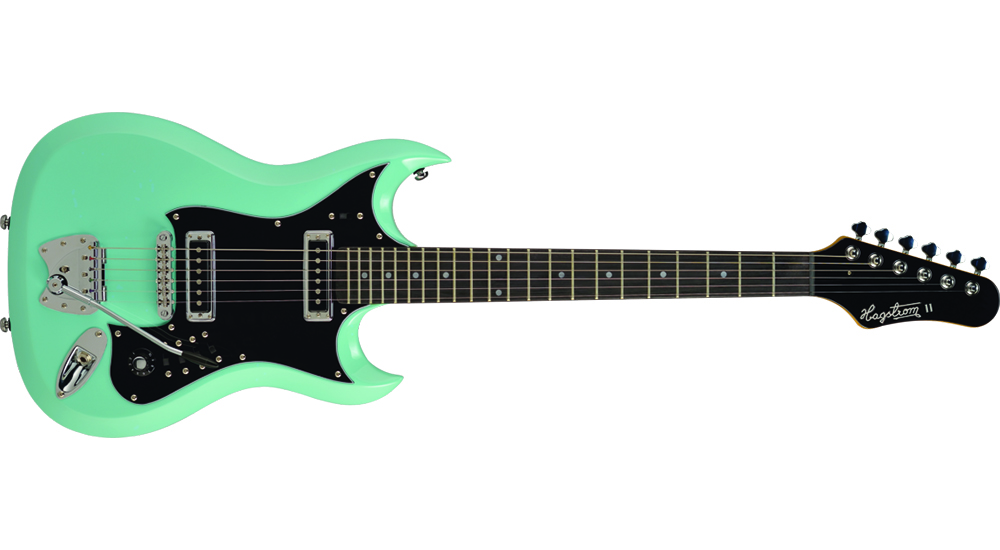Their first electric guitar models were accordion-inspired, covered in pearloid celluloid rather than your standard lacquering; they developed the Speed-O-Matic fingerboard made of plexiglass for speed and precision; their original H-bar truss rod was responsible for producing stronger, thinner necks that in many countries came with a 10-year guarantee; and with the H8 they developed the world’s first mass-produced eight-string bass in 1967.
In the 25 years leading up to 1983, when Hagstrom ceased manufacturing electric guitars and basses, the company produced close to 130,000 units, making their way to all corners of the globe. And while 22 years passed without the beloved manufacturer selling a single guitar or bass, its imprint on the industry – one of ingenuity and craftsmanship – clearly never faded, leading to a 2005 relaunch. Now in full effect, Hagstrom are expanding their presence in Australia – the perfect opportunity to explore the models and design principles that once elevated, and continue to define the Hagstrom brand.
THE HOME OF HAGSTROM
In Alvdalen, Sweden, 1925, Hagstrom was established as a manufacturer of accordions. Through perseverance and a willingness to venture beyond the manufacturing norm, the company grew in leaps and bounds – peaking in 1952 with the manufacturing of 15,000 accordions, sold at branches in the US, England, Finland and Denmark. It was from this point onwards that Hagstrom were to experience a period of transition compelled by a falling demand for accordions, and the imminent rise of the electric guitar. In 1958 this change in direction was set in stone with the release of the Hagstrom Deluxe and Standard electric guitar models. These were guitars influenced heavily by the manufacturer’s fist life as a maker of accordions – an odd foundation that informed their initial success and fostered future endeavours.
Hagstrom had already experienced international expansion and recognition as a quality maker of instruments. Additionally, the manufacturer was accustomed to dealing with the issues accompanied with operating in a smaller European market, relating to: the sourcing of materials and machinery, the development of technique and process, and the availability of qualified craftsman. Beyond these challenges, Hagstrom were approaching the manufacturing of guitars and basses from a unique operational background, one that had to be repurposed to meet these new production demands. With the very same perseverance and creative guile that brought recognition to their line of accordions, Hagstrom used these challenges to fuel and shape the personality and qualities of the many guitar and bass models to come.
ONE OF A KIND
As one of the first manufacturers to produce electric guitars outside of the US, Hagstrom entered the fray armed with a refreshing outlook on materials and technique. From day dot, the Deluxe and Standard models were striking in appearance – finished in a ‘mother-of-pearl’ shine, with a Les Paul-inspired double cutaway and stamped metal logos – and loaded with exciting features including the Speed-O-Matic plexiglass fingerboard, and a super low action thanks to the H-bar truss rod. Later came the introduction of the Viking in 1965, Hagstrom’s first semi-hollow electric guitar, famously played by Elvis in 1968 at the Elvis Presley Comeback Television Special. And then the Hagstrom Swede, based on the Les Paul, yet smaller in stature, more compact, and further refined with a contoured back that followed the shape of your body. New humbucking pickups were specifically designed for this guitar, which was used most prominently by ABBA’s Björn Ulvaeus.
In 1961 Hagstrom began a brimming relationship with the bass guitar, releasing the Deluxe electric bass, equipped with a Speed-O-Matic fingerboard, a pearloid celluloid finish and a double cutaway. However the height of their bass guitar manufacturing was to come in 1967 with the unveiling of the world’s first mass-produced eight-string bass, the Hagstrom 8. Based on a regular four-string Hagstron bass, each string on the H8 was doubled with a similar technique employed to that of a 12-string guitar. The lighter string was situated above the standard string and tuned one octave higher, providing a myriad of technical and tonal options for soloing. As such, it found its way into the hands of the Jimi Hendrix Experience’s Noel Redding, The Blues Project’s Andy Kulberg, and the Allman Bros/Sea Level’s bass player Lamarr Williams.
A TIMELY RESURGENCE
With Hagstrom once again in operation, the ingenuity and creativity that defined the company throughout the 20th century is alive and kicking, this time accompanied by a nuanced understanding of the modern player. It’s a resurgence that honours the successes of past guitars and basses through the reimagining of the very traits that made these one-of-a-kind instruments so unique. The H-bar truss rod is now the H-expander truss rod, providing tension at both ends and running the entire length of the neck. This delivers that enticing extra low action and thin neck for heightened playability, enhanced sustain, and a rounder attack for a more dynamic response. In line with their history of using alternative woods, Hagstrom today utilise Resonator wood for their fingerboards – a composite material characterised by its consistent and uniform density. While the string-isolating Sustain Block Tailpiece, which made its first appearance on the Swede and Super Swede guitars produced in 1978, is another notable feature to make a comeback.
At the forefront of Hagstrom’s rebirth is the Northern Series line of guitars. The Northern Super Swede is a prime exponent of the classic Hagstrom tone, armed with a No.2 set of Johan Lundgren custom made humbuckers that deliver tonal girth and warmth, plus all the twang one could desire thanks to the individual coil tap for each pickup. The Retrostar Series, on the other hand, brings back the eye-catching shapes and retro features of past guitars into the here and now – the Impala reviving the ‘Vintage Tremar’ vibrato unit with a funky body shape and two Alnico-5 Retro-S pickups to recreate the sounds of 60s mania. And lets not forget the HB-8; the eight-string bass equipped with Hagstrom’s own humbucking Dyna-Rails and a six-way rotary pickup switch for a plethora of mind-blowing tones and textures. As if they never stopped manufacturing, Hagstrom are once again altering and redefining what we look for in a guitar and a bass – a welcomed alternative to the unchanging norm.
Hagstrom Guitars are distributed throughout Australia by Pro Music. For more information about the guitars, and where you can find them, visit promusicaustralia.com.

